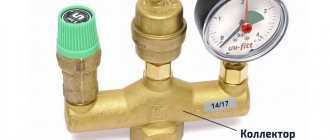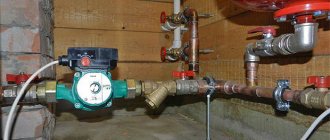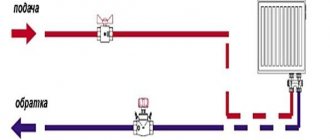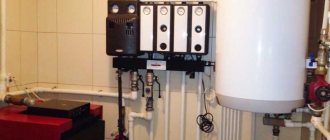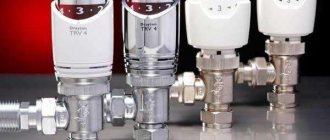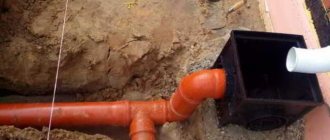One of the most common problems in functioning heating systems is airing, which leads to uneven heating of radiators or underfloor heating pipes. To combat this negative phenomenon, air vents for heating systems operating in different modes are widely used.
Using an air vent installed at the inlet of the heat exchange devices, air is released from the heating circuits. There are various types of air vents on the market, in order to understand the wide range of models and choose the right device for an individual heating system, you should know the operating principle, existing types and design features of manufactured air vents.
Rice. 1 Air vents
Installation of an automatic air vent for air release
A characteristic feature of heating systems using liquid coolant is the appearance of air pockets. Many people who use this type of heating face this problem. In open circuits, air leaves naturally, but for closed circuits it is necessary to use a special device to help get rid of gas contamination. Such a device is an automatic air vent. Air has a negative impact on the operation and service life of the heating system. Gradually, a corrosion process occurs due to the reaction of iron with oxygen. Also, the plugs do not allow the coolant to move normally along the circuit, which leads to weak heating of individual elements of the system. The occurrence of bubbles entails premature failure of even the highest quality circulation pumps. There are several main reasons why air locks appear:
- 1. For the coolant, ordinary tap water is used, which has not undergone processing steps that help remove dissolved oxygen. During heating, it again acquires gaseous form and accumulates at the turning or upper points of the heating system.
- 2. Very fast filling of the pipeline with liquid.
- 3. The coolant supply is not from the lowest point. This prevents water from displacing all the air from the system.
- 4. Leaks or damage to connecting elements.
- 5. Using pipes that are not designed for hot water.
- 6. Errors during system design.
- 7. Installing the radiator without observing the required angle of inclination.
- 8. Accidental air intrusion during repairs.
If plugs constantly appear in the same place, it is recommended to install an automatic air bleeder for the heating system. This will solve the problem with lowering pressure.
Air bubbles in the liquid usually accumulate in certain places in the pipeline or inside the batteries. The resulting plug gradually increases, which leads to partial or complete blocking of the circulation of hot water in a particular area. Some sections or entire radiators may stop heating completely. To get rid of air in the heating system, two types of air bleeders are used:
- mechanical Mayevsky valve;
- automatic air vent from the heating system.
During the Soviet Union, air separators of this kind were not used. In private buildings, open-type heating was usually used. In this case, the air came out through the expander. Centralized networks were supplied with air vent valves. They were often mounted at the highest points.
The design of a mechanical air deaerator is quite simple. It often has a brass body and ½ or ¾ threaded connections. inches There is a small hole on the side of the device, which is necessary to bleed air from the system.
Some models of mechanisms are equipped with a special plastic insert. There is a small outlet channel inside it. This allows you to operate the device with greater convenience, since its position can be adjusted thanks to a plastic washer . The mechanical vent functions as follows:
- 1. When operating heating systems, the screw from this device is tightened and completely covers the outlet.
- 2. If it becomes necessary to release the accumulated air accumulations, then unscrew the screw a little. The pressure of the coolant squeezes out the plug.
- 3. First, clean air comes out of the radiator, and then mixed with liquid. The Mayevsky valve closes only after water begins to flow from the hole.
Mayevsky's manual crane is able to work correctly for many years. This trouble-free device has a long service life.
Often the device is mounted on a radiator. Mayevsky taps have different ways of unscrewing. For this purpose, you can use a plastic or metal handle, a regular screwdriver or a four-sided wrench.
The automatic air vent can be used for both heating and hot water supply systems. Such a device operates without any human intervention. The mechanism consists of a brass body and a barrel located vertically, and has threaded connections. There is a plastic float inside the device. A valve is connected to it, which is exposed to water. The operating principle of an automatic air vent for heating is as follows:
- 1. When the chamber is in working condition, the body is filled with water, which puts pressure on the float and presses it up. The air valve is closed.
- 2. As air accumulates in this chamber, the liquid level begins to decrease. The float gradually lowers.
- 3. When the amount of water critically decreases, the valve opens, which leads to the release of accumulated air to the outside.
- 4. After complete displacement, the entire mechanism returns to its previous position. The valve closes again.
When the heating system fills with liquid, air is constantly released until the float rises to the top of the chamber. After filling the tank with water, the spring begins to act on the valve, and it closes the hole.
Automatic gas vents can be with angular or direct connection. Some manufacturers make the design so that the discharge occurs vertically, while others - to the side. For normal household use, such differences have virtually no significance.
Companies producing self-releasers are constantly improving their products. Leading companies provide products with some additional functions, which include:
- 1. Protect the device from water hammer. To do this, a reflective plate is added to the design.
- 2. Additional horizontal fittings. They serve to more effectively collect small air bubbles.
- 3. The mini-valve can be installed directly into the radiator plug.
Also, some models allow you to dismantle the valve without draining water from the system. This is possible thanks to the built-in shut-off valve. When unscrewing the element, the spring begins to straighten and presses the gasket against the radiator inlet.
In any heating system using liquid coolant, there are certain areas where it is imperative to install an automatic drain. Mechanical Mayevsky valves should be installed on all radiators so that it is always possible to bleed off excess air. The automatic device should be installed only in a vertical position in the following wiring areas:
- 1. To the safety group of a heat generator connected to a closed heating system.
- 2. On all heating collectors made like underfloor heating.
- 3. At the highest point of the contour.
- 4. On the heated towel rail.
- 5. In all distribution combs.
- 6. It is advisable to mount the device in a hydraulic arrow.
Also, these devices are installed at all problem points of the network, especially where U-shaped loops appear that are turned upward. In such places, air jams cannot be avoided.
When it comes to mechanical valves, they should not be installed directly into pipes. This way the air will pass by the device, and instead of the plug the coolant will come out. In this case, the device is completely useless. Automatic air vents are equipped with a special chamber that catches all bubbles. The best option would be to install a corner mechanism. Many people refuse such a device because the flask is very noticeable. To keep the tank out of the way, you can take a mini-model of the sump.
The most important recommendation is that you should not buy valves made in China. Almost all models of this origin are of dubious quality. The consequences of such savings can lead to the following:
- 1. In parallel with the air pockets, the device will leak liquid. This leads to a drop in pressure in the circuit, as well as to the appearance of leaks on the body, walls and floor.
- 2. A poor quality air vent may simply not work.
- 3. The coolant quickly renders all structural elements of the valve unusable.
With mechanical devices, this problem occurs much less frequently, since there is practically nothing to break in their design. These products are not some kind of complex equipment, so their cost is quite low. Even well-known manufacturers (for example, Valtec) provide products at an average price. Spirotech machines are also famous for their high quality characteristics. Basic tips for choosing:
Features of installing an air vent in a private house
You will need a wrench for installation.
An air vent designed for heating communications in a private home must be installed strictly in a vertical position. For installation work you will need a threaded tee, FUM tape, and an open-end wrench.
The installation process is carried out in stages:
- Tee fastening. You will need a piece of pipe onto which a tee is fixed by soldering, glue or simple shrinkage.
- Preliminary check of the location of the vent at the highest point of the equipment. The device connection must have an upward direction.
- Installing the shut-off valve on the hexagon of the device using an open-end wrench.
- Connect the automatic air vent so that the protective cap with nipple faces upward.
- Screw the cap tightly to prevent debris from accumulating.
- Checking the tilt of the device (for radiator models). The battery section with the drain rises slightly.
After installation, the devices do not need to be adjusted - they will bleed air automatically.
It is better to install the air vent with a shut-off valve - this makes it easier to remove it for repair or replacement.
How does an automatic air vent DN15 (1/2) work in a heating system?
The presence of air in the heating system is extremely undesirable. However, he gets there one way or another. This has a very detrimental effect on the quality of operation of the heating system as a whole and reduces the service life of its individual components. In order to remove accumulated air, an automatic air vent is needed.
In this article we will talk in detail about this device, the principle of its operation, marking features and popular models, as well as how to properly install it in the heating system.
Air in the heating system - why is it bad?
It would seem that the heating system is closed, completely filled with coolant, where does the air come from? There are several ways for it to appear inside, among them there are several main ones:
While filling with coolant
While you fill the heating system with water or other coolant, it mixes with air. It is almost impossible to avoid this, so you have to take it for granted.
Through poor connections
Poor installation of the heating system, installation and connection of a solid fuel boiler or other heating device, poor quality, defective or broken shut-off valves or other elements - all this leads to air penetration inside.
Chemical reactions
In addition to air, other gases can accumulate inside. For example, if you use a coolant with high acidity and aluminum radiators, hydrogen will be released as a result of a chemical reaction.
Photo 1: Automatic air vent for heating systems
As you can see, there are many reasons for this phenomenon. But why is this so bad? The first thing this leads to is cavitation. It significantly accelerates the wear of equipment and leads to noise during its operation. The second reason is corrosion. It destroys the elements of the heating system and carries their particles with the coolant flow to other devices, clogging and interfering with their normal functioning. Thirdly, the presence of air reduces the actual heat transfer of heating devices and leads to disruption of the pumps. It can even cause a rupture of the boiler casing.
To eliminate all these problems, an automatic air vent is used. Let's figure out how it works in the heating system and what components it consists of.
Return to contents
Where are the air release valves located?
In any water heating system there are places where the installation of air vents is mandatory. If we talk about Mayevsky’s taps, then they need to be installed on all batteries in order to bleed off the collected air. The exact location is in the plug of the upper corner, distant from the point of connection of the supply line to the device. An air bubble forms there.
If the boiler is equipped with a built-in air vent, then there is no need to install it on the supply
The automatic air valve must be installed strictly vertically at the following points in the heating network:
- in the safety group of a boiler connected to a closed type system;
- on both underfloor heating collectors;
- if the highest point is a pipeline and not a radiator, then a float air vent cuts into it;
- into a buffer tank and an indirect heating boiler, if provided for by the design;
- on the heated towel rail coil;
- into the common distribution comb of a complex and branched system (to both collectors);
- to the hydraulic circuit separator (hydraulic arrow).
In addition to the indicated points, air vents are installed in problem areas of the heating network, where, due to difficult installation conditions, pipes form U-shaped loops turned upward. For example, a highway goes around a doorway or flight of stairs at the top, and then goes down again. In such compensators, air pockets form with a 100% probability, so an air vent is needed, preferably an automatic one.
When the highest point of the network is a pipe or compensator, a valve is mounted on it
Advice. Never cut the Mayevsky valve directly into the pipeline, since the bubbles will pass by it along with the coolant flow and the valve will be useless. For proper operation, a manual “bleeder” needs a chamber to collect air (the “automatic” has its own). Make a vertical pipe into the main line, which will serve as an air collector, and install a faucet on top.
If, when filling the heating network with water, you do not want to run between the radiators with a screwdriver, install automatic corner air vents instead of Mayevsky valves. This option is also suitable for residents of centrally heated apartments: air pockets often occur in cast iron radiators, and there is no way to remove them from there.
Another tip. To prevent the corner air vent flask from sticking out in plain sight and clinging to the curtains, take a mini-model of the valve built into the radiator cap.
Design and principle of operation of an automatic air vent
The design of this small device is very simple. Inside the brass body there is a polypropylene float which is connected via a rocker arm to the spool. As the body fills with air, the float moves down and opens the exhaust valve. The freed space is filled with water and the rising float closes the spool. To prevent various debris, dust and dirt, from getting inside the spool, its outlet hole is closed with a plastic cap.
Photo 2: Design of an automatic float-type air vent
There are models with a slightly different implementation of this process, but in general it is always the same: when the float is down, the valve is open and releases air; if it is raised, the spool closes and the device accumulates gas again. This cycle is repeated again and again automatically.
Return to contents
Link to video to text
A completely simple but important device - the air vent valve in the heating system performs an important function. The reliable circulation of the heating medium and the efficient operation of the heating network installation as a whole depend on its presence in the circuit. Moreover, the device is part of the so-called safety group, since it helps to automatically release air. The installation locations for vents are indicated by the heating network design. The same document establishes the standard size and modification of the protective device. Many types of heating equipment, including boilers running on gas fuel, are equipped with air vents already at the factory, during the assembly of devices and units.
Types and markings, popular models
There are several types of automatic air vents. All of them are divided into two large types: automatic and manual air vents for radiators or Mayevsky taps.
Depending on the diameter of the threaded connection, they are of two types: 1/2 and 3/4 inches. The first is better known by Russian markings as an automatic air vent valve Du 15, the second - Du 20.
According to the method of fastening, they are divided into classic straight and lateral. For air vents of the second type, the threaded connection is rotated 90 degrees. The air release valve may also be located on the top or side. Various modifications are produced by the manufacturer to facilitate installation in difficult places in the heating system or for mounting on the side of radiators.
Photo 3: Automatic air vent DN15 “Valtec” VT 502 with shut-off valve
In the domestic market, the two most famous are Danfoss. supplies the Russian market with an automatic air vent VT.502 with a mounting diameter of 1/2 (DN15). The model has proven itself well and is very popular among installers of autonomous heating systems in private homes. It has a brass body coated with a layer of nickel, which is designed for a maximum pressure of 10 bar and a temperature of 110 °C. The average price at which you can currently buy this model is 280 rubles.
Photo 4: Automatic air vents 1/2 "Danfoss" series "Eagle" and "Wind"
Takes second place. It produces automatic air vents in two series: “Eagle” and “Wind”. Despite the general technical characteristics, they differ only slightly in appearance. The models are made in brass cases and are designed for a maximum pressure of 10 bar and a temperature of 120 °C. In addition to the standard mounting thread DN15 (1/2), Danfoss also produces automatic air vents with fastening 3/8 (DN10). Prices for these devices are also within 300 rubles.
Return to contents
Choosing an air vent: expert advice
Such an important mandatory safety device for any heating network as an automatic air vent for heating must be chosen correctly.
It is usually supplied complete with other boiler equipment. If the home owner still has to choose an automatic air vent on his own, it is recommended to pay attention to the quality of the material from which the valve is made. It is necessary to protect yourself from all kinds of silumin fakes that imitate copper modifications. Professionals recommend choosing automatic devices with exhaust pipes directed upwards. According to reviews from numerous customers, on models with side outlets, leaks occur much earlier.
In addition, during installation it is necessary to ensure the vertical position of the device. Main recommendations for selecting air vents:
- It is more reliable to purchase a motorized air vent with a plastic or iron handle; this eliminates the need to carry various keys or screwdrivers with you. This faucet is convenient to use even in hard-to-reach places.
- In the case where young children live in the apartment, it is recommended to install an ordinary manual air vent, made for screwdriver control. Otherwise, children will be able to unscrew the air vent with a handle and scald themselves with boiling water.
- It is advisable to purchase devices with a self-acting cut-off device.
- If the estimate allows, it is possible to order a mechanism with additional options that can make servicing the heating network more comfortable.
- The high-quality anodized coating of the air vent essentially plays absolutely no role, but only reduces the level of rust formation on metals.
- Today in the retail chain it is possible to find combined modifications of heating network devices, which are also equipped with air vents. This list includes balancing valve devices, a variety of shut-off and safety valves and electric coolant circulation pumps.
Installation in a heating system
Small air bubbles traveling through the heating system are collected into larger ones, which rise higher in the heating system. It is for this reason that it is recommended to install automatic air vents at the highest points of the heating system. The most susceptible to the formation of air locks are water heating boilers, collectors, radiators and other U-shaped areas, which are also equipped with these devices. Automatic or manual air vents for radiators are installed in residential premises, and heating boilers are protected by special safety groups for heating boilers.
Photo 5: Installation of an air vent as part of a safety group
To avoid draining the coolant from the heating system when dismantling the air vent for repair or replacement, a shut-off valve is installed in front of it. It consists of a brass body with a plastic spool inside. The shut-off valve is open when the air vent is screwed into it. When unscrewed, the valve automatically closes, isolating the heating system.
In addition to our story, watch a short video about automatic air vents:
The automatic air vent is an extremely important element of the heating system. Despite its small dimensions and simple design, it reliably protects the system from the destructive effects of air. The correct selection and installation of this cheap device will save you significant money on repairing expensive components of your home’s heating system.
Separators for degassing and sludge removal
Fig.1 Separator
The separators that appeared in recent years in the Russian Federation began to be produced in Europe more than 30 years ago and have become a standard element for degassing and removing sludge from heating and water supply systems. In addition to removing plugs, separators remove microbubbles and sludge particles from the water flow and combine the functions of air vents, filters and deaerators. Separators do not require consumables, energy or maintenance, operate for several decades, and have a simple and reliable design without moving parts.
The universal separator is a metal cylinder with an air vent at the top, a sludge discharge valve at the bottom and a stationary mechanical separating element inside (Fig. 1). An element inside the separator ensures rapid transport of microbubbles to the top and deposition of insoluble particles below as the water flow passes through the separator. The separator's automatic float air vent removes air accumulated at the top, and periodic sludge removal is carried out manually using a ball valve at the bottom of the separator. In both cases, the system does not depressurize. When the system is initially filled with water, large air bubbles are quickly removed using a special valve in the air vent housing. Separators are installed vertically.
Separators from different companies, as a rule, differ in different types of separating elements. In Pneumatex separators (Switzerland), such an element uses a petal spiral (spirals) with a profiled surface made of stainless steel, installed vertically along the axis of the separator (Fig. 1). The mechanisms for extracting gases and solid particles may also be different. As a rule, the gravitational mechanism of particle sedimentation and bubble sublimation is used. To enhance the effect, the flow speed inside the separator is reduced (the cross section is increased), and the flow is laminarized. Some models use a centrifugal effect to spin the flow inside the separator. When using working elements with a large area, the mechanism of sorption of microbubbles on the surface is activated with their further merging into larger bubbles and floating up.
The range of application of separators is quite wide.
For example, Pneumatex industrial separators (standard sizes DN 50 – 600 mm) are capable of processing flows in the range of 5 – 2000 m 3 /h. The housings of industrial separators are made of steel.
Brass separators for small objects (standard sizes DU 20 – 40 mm) process flows up to 5 m 3 /h. All brass separators are assembled from basic elements and can be easily transformed.
Why is air in a heating system dangerous?
When air appears in the heating system, a plug forms. This causes one part of the pipeline to remain cold and another to overheat. When air from all heating circuits accumulates in one place, the movement of the coolant completely stops. What does this mean:
- When an air block appears in a closed circuit, pressure increases in the system. Because of this, the safety valve is activated.
- It will constantly operate and remove water from the system until the heating equipment burns out.
- Sometimes pipes burst due to this pressure.
To prevent this and eliminate the problem, install an air vent. In addition to these difficulties, the presence of air in the circuit will lead to oxidation of the pipe, rust and a decrease in service life.
Characteristics of air vents
It is convenient to present the technical features of the device in the table.
| Options | Peculiarities |
| Device service life | Up to 30 years old |
| Operating water temperature | From – 10 to + 120 C |
| Maximum room temperature | Up to + 60°C |
| Automation pressure | 10-12 bar (16 atm.) |
| Internal ? connections | 1/2, 3/4 inches (Du 15mm and DN 20mm - for metric units) |
| Thread type | External, internal |
| Valve material | Body – brass, float – polypropylene |
| Type of design | Straight, angular, radiator |
| Features of the coolant | Water or other liquid non-aggressive medium |
These parameters must be selected taking into account the type of network. For individual heating, the choice is unlimited; for centralized systems, you need to find out the pressure and temperature of your home at the housing department.
The cost of an air vent device depends on the model, manufacturer, material, connection (1/2 inch - 10-15% more expensive). The budget option can be purchased for $5, the most expensive is $15.
It is worth spending time choosing a supplier: in one store, an automatic air vent for heating Danfoss DU 15 is offered for $7.63, in another the same model is offered for $11.5.
When purchasing branded appliances from well-known brands (Danfoss, Wind, Valtec), beware of counterfeits. The price range for a shut-off valve is from $1.1 to $1.8.
The automatic air vent is divided into the following main types:
1. Permanent air vent. Fig. 1. This means that the automatic air vent removes air and gases constantly in a filled system. It is characterized by high reliability, relatively low throughput and, as a rule, works both for air intake and exhaust. These are models for both domestic and industrial use, for example on risers of residential buildings.
2. Starting air vent. Fig. 2. Used to quickly remove air when filling systems, then it closes and does not remove air. An automatic air vent of this type can operate only to release air, or to release and start while the system is draining. As a rule, these air vents are used only on water systems with temperatures up to 60C.
3. Combined action air vent. Fig. 3. This automatic air vent in its design has 2 floats - a large one for starting or emptying the system and allowing a large amount of air to pass through, and a small one for operating the valve when the system is already filled. Such valves are mainly used in water supply and sewerage systems, much less often in heating systems.
Incorrect security group setting
It is installed on the feed. Due to ignorance or illiteracy, many, when installing a safety group, place a shut-off valve between the boiler and the safety group (Fig. 1),
or directly to the security group (Fig. 2),
arguing that if the boiler fails, it will be possible to replace it or carry out repair work. In both cases, the installation was carried out incorrectly and, if the boiler fails, the service centers will refuse you warranty repairs, arguing that the boiler was installed incorrectly: this arrangement of the valve makes it possible for the system to overheat and the boiler to fail in case of shutdown shut-off valve by workers, third parties or children.
Causes and consequences of air locks in an open heating system with natural circulation
If the pipe slopes in the system are correctly designed, then all the air will be released through the open expansion tank, which is located at the top point of the heating circuit. There can be several reasons for an air lock:
- After repairs, air remained in the heating radiators;
- Incorrect (too fast) filling of the system at startup;
- The circuit is filled with water through an expansion tank;
- When heated, air begins to be released from the water, which was previously in a dissolved state;
- When filling the circuit, water was supplied from above.
The consequences are not difficult to predict - stopping circulation, cold batteries, rapid corrosion of the internal surface of system elements. To avoid this, it is enough to install manual air vents on all radiators - Mayevsky taps.
Review of manufacturers
Automatic air vents for gas release are:
- brass with a polyethylene float that is not subject to oxidation;
- cast iron with epoxy coating;
- brass with nickel coating and polyethylene float;
- made of stainless steel.
Among the companies producing automatic air vents for heating systems, the following brands have gained a good reputation.
- Flamco company from the Netherlands. It produces Flexvent domestic air vent valves. The body of the parts is made of brass; the products are mounted in circuits with a small amount of air masses. Mainly intended for batteries.
- The Portuguese company Adca specializes in valves for the industrial segment and heating circuits. The products are made exclusively from stainless steel and are installed in heating circuits with a maximum coolant temperature of no more than 300 degrees.
- Mankenberg produces high quality air vents. The main difference between air vents from this manufacturer is the ability to be installed in heating systems with various types of coolants, even aggressive ones. Air vents are made of stainless steel.
- produces air bleed valves mounted on water supply, heating and sewage systems. Russian-made devices are currently manufactured for heat supply systems - the KAT12 series, water and sewer circuits - the KAT50 series.
- Armstrong is considered the most sought-after manufacturer of high-end automatic air vents throughout the world.
What type of radiators require air vents?
Automatic radiator models are primarily intended for aluminum heating devices in which gas formation occurs due to contact of the coolant with the metal. It is also recommended to equip partially bimetallic radiators with an air vent valve. Fully bimetallic batteries have a steel core, which allows the installation of a manual valve.
Types of radiators for heating systems
Steel panel heating devices are equipped with a standard Mayevsky manual tap; a drain valve is mounted on cast iron radiators and tubular steel radiators.
Note! Do not smoke or light a fire near an aluminum battery equipped with an automatic valve for releasing gases. The device releases explosive hydrogen generated during a chemical reaction.
Where are air vents installed?
In a closed system, when installing a device for effective gas removal, certain rules must be observed:
- The pipes are laid so that the vectors of movement of water and air coincide, and the hot liquid is directed from the main riser to distant ones.
- The air collector must be mounted at the highest point, for example, when going around a doorway from above, since air is released from the liquid at low water speed.
- Devices for removing air should be placed in areas where gas accumulation is guaranteed: at turns of risers, in places where pipes change to another cross-sectional size, on all batteries, separators, and combs.
It is mandatory that air vents are mounted on aluminum radiators, which release hydrogen upon contact with the coolant. For partially bimetallic batteries, the problem is not so urgent, but they do contain aluminum, which means that gas will have to be removed, although not so often. There is no aluminum in 100% bimetallic models, but manufacturers strongly recommend using them together with devices for bleeding air.
Separators with magnetic traps
Pneumatex separators with magnetic traps (DN 20 – DN 400 mm) trap insoluble iron impurities in water much more effectively than conventional separators. The rod(s) with a powerful magnet are inserted from below from the outside into the separator sleeve and removed before the operation of washing out the sludge without violating the tightness of the system. The magnetic rod is separated from the water by the walls of the sleeve and does not require cleaning or protection from corrosion. The sleeve is made of non-magnetic material, so the magnetic particles quickly settle down and then the sludge is washed away through the valve. For effective flushing, the valve is offset from the center (creating a vortex effect). Separators with magnetic traps also contain conventional separating elements and have all the degassing and non-magnetic particle removal properties of conventional separator models.
How to disassemble
It often happens when using automatic air vents that they begin to leak. In this case, plaque and mechanical deposits appear on the needle-type valve. In this case, the tap closes completely, the coolant flows out, that is, the tap is leaking. It is necessary to dismantle the device, disassemble it, clean the needle itself, the seat and other disassembled parts with a soft tool. With good cleaning, you may not notice such problems until the next time precipitation occurs. To assemble the air vent, it is recommended to use FUM tape as a thread seal, and the body is screwed in by hand.
Design and operating principle of manual air valve
The needle manual air valve is also called a Mayevsky valve. His device:
- Brass body (plug) with external thread 1/2// or 3/4// for connection to the radiator. The case has two holes for air release Ø 2 mm - one at the end of the case, the second on the side wall;
- Brass locking screw. On one side of the screw there is a groove for a slotted screwdriver, on the other side the screw is machined into a cone that closes the air hole (the “closed” position);
- Plastic casing.
On sale you can find the so-called “faucet at hand”. To use it, you don’t need a key or a screwdriver—the plug can be easily unscrewed by hand.
To remove air from the housing, you need to unscrew the screw. To do this, you can, of course, use a screwdriver, but there are special keys that are most often included. After several revolutions, the screw cone comes out of the end hole and air enters the housing cavity, which is immediately released through the second side hole. The main thing is not to rush to turn off the tap. About 30 - 40% of the air should come out with water, so you need to stock up on time, a basin and rags. After the air has been released, the lost water must be added to the system.
Installation
Modern aluminum or bimetallic heating radiators already have a hole for installing a Mayevsky tap. It can be found on the side opposite the coolant supply, from above. Most likely, there is already a nut for installation there. There is a plastic plug screwed into it. After its removal, an air valve is installed in this place. Before this, the tap threads must be sealed with a rubber or silicone gasket.
Installing a Mayevsky crane on a cast iron battery is much more difficult. Let's start with the fact that these valves are much more powerful than those on aluminum radiators - they can withstand pressures of up to 16 atmospheres and temperatures of 150 C°. Sequencing:
- Drain the water from the radiator;
- Cut a hole in the top plug of the cast iron battery and cut a thread that matches the external thread of the air vent;
- Screw in the Mayevsky tap;
- Add water to the system.
Malfunctions and ways to eliminate them
If the faucet malfunctions, a leak appears. There may be several reasons for this:
- Manufacturing defects. One in fifty taps does not hold pressure at all. The only way out is replacement;
- The screw is too short. In this case, its conical part cannot completely block the hole, so you need to apply a certain force to screw the screw in until it stops;
- Solid particles of debris falling between the screw and the housing can damage the internal threads. Fum tape can help here once, but later you will still have to change the tap.
Mayevsky crane
Of course, Mayevsky’s faucet does not belong to the category of automatic air vents, so it seems to be off topic of the article. But there’s not much to write about it, and since it’s still an air vent, a few words about it here.
Mayevsky taps are installed on radiators:
To bleed air, you just need to slightly open the screw on the tap with a screwdriver:
The blue arrow shows where the air will come out from.
If initially (when installing heating) we plan to install a Mayevsky tap, then we need to install the radiator so that the part where the tap is “looks” upward (1...2 cm higher).
Causes and consequences of air locks in a closed heating system with forced circulation
The reasons are the same as for an open system, plus:
- A loose circulation pump impeller can “grab” air during operation;
- If hot water is supplied to the expansion tank from above, then air can enter the system through cracks or breaks in the tank membrane.
An air lock in a closed circuit will lead to increased pressure in the system and activation of the safety valve. The valve will bleed water over and over again until the boiler burns out or the heating pipes rupture. Therefore, security requirements for closed systems are much stricter. In particular, for air release, the closed circuit is equipped not only with manual Mayevsky valves, but also with automatic air vents. One of these automatic valves is included in the safety group. The group is placed on the water supply, immediately after the boiler.
Reasons for appearance
Air can appear in the heating system for various reasons. If this is a one-time problem, you can simply delete it and not search for the source. If deflation is required several times during the season, you will have to look for the reason. Here are the most common:
- Repair and modernization of the heating system. During repair work, air almost always gets into the pipeline. It `s naturally.
- Filling the system with coolant. If you pour water into the system slowly, it carries little air with it, simultaneously displacing the air that is in the pipes and radiators. This is also an understandable process and does not require any special measures.
- Depressurization of joints and welds. This defect requires elimination, since airing will occur constantly. In individual heating systems, this phenomenon (leaky connections) is also accompanied by a drop in pressure. And this is another reason to look for faults. The most likely location is pipe and radiator connections. They may not be sealed. It is very difficult to look for them, since they do not always appear outwardly. If you notice that one of the compounds is leaking, everything is much easier - eliminate the drops. But if outwardly everything is normal, and air accumulates all the time, you have to coat the joints and seams with soap foam and observe whether new bubbles appear. After finding each “suspicious” connection, they are tightened, coated with sealant or repacked (the method depends on the type of connection).
Air can accumulate in pipe bends.
- If the heating system already has air vents (valves for releasing air) and plugs begin to appear in it, you need to check the serviceability of the valves, as well as the tightness of the connections.
- The appearance of air in the heating system may be due to a rupture of the expansion tank membrane.
In this case, you will have to change the membrane, and to do this you need to stop the entire system. These are the most common places and ways in which air gets into radiators and batteries. It is necessary to kick him out of there from time to time, but when starting the heating in the fall, it is necessary.
Automatic air vent: design, operating principle, installation
The presence of air and microbubbles in the heating system leads to a decrease in efficiency and disruptions in its operation:
Automatic air vent, max. temperature 110 °C, 10 bar.
- The heat output of radiators is reduced. Air fills the top of the radiator, causing it to become cold;
- Oxygen present in the air contributes to corrosion of the internal walls of equipment;
- Coolant circulation decreases or completely stops;
- The blades and bearings of a circulation pump with a wet rotor are subject to increased load, as a result of which the pump may fail prematurely;
- There is constant noise in the radiators, pipes and circulation pump.
One of the most effective devices that can solve all of the above problems is an automatic air vent - a device designed to automatically bleed air from the heating system.
Do-it-yourself hydraulic arrow for heating
Since the structure of the device is simple, many people want to make it themselves.
Calculations of the size of a hydraulic arrow for heating begin with the diameter of the pipe, which is suitable for a particular system.
For calculations you will need the following data:
- Boiler power (kW) - W.
- The difference between the flow and return temperatures is ΔT.
By substituting the data, you can use the formula to calculate the minimum internal diameter (D) in mm.
2-3 internal diameters of the device should “fit” between the nozzles.
But not everything is as simple as it seems. To make an arrow yourself, you need welding skills. The services of a hired specialist will cost quite a bit. It is not always easy to find high-quality pipes with straight threads, then you will have to resort to the services of a turner. As a result, the total cost of materials, labor and time may even exceed the cost of purchasing a ready-made factory device.
There is one more point in which homemade products are inferior to factory-made analogues. Since they do not have a thermal protective casing, the separator radiates heat where it is not intended by the owner.
Automatic air vent device
Design and principle of operation of an automatic air vent valve.
An automatic air vent is a sealed brass body, usually cylindrical or cone-shaped. The body contains a hollow float made of polypropylene or high-quality Teflon, which is connected by means of a lever to the drain valve. The drain valve is equipped with a plastic locking cap-plug, which prevents coolant leakage in the event of a device breakdown.
Types of automatic vent valves.
There are 3 types of automatic air vents:
- Direct traditional (installation is carried out vertically);
- Angled (at an angle of 90°). They are used as radiator valves instead of a Mayevsky tap or in cases where the design of the heating system does not allow the use of a direct air vent;
- Special air vents for radiators.
Installation principles
The automatic air release device is installed vertically - for both straight and corner models, the cap covering the outlet is directed upward. A ball valve or shut-off valve must be installed in the pipeline before the drain valve.
Attention! An exception is the air vent in the boiler safety group - there should be no shut-off valves between this unit and the boiler pipe.
A shut-off check valve allows you to clean the air vent or replace a faulty device without draining all the coolant from the circuit. The automatic air vent with a check valve is easy to use.
When installing an automatic Mayevsky crane, use a wrench rather than an adjustable wrench to control the tightening force of the fasteners. In this case, you should not hold the device by the body, so as not to break it. Hold the air vent by the hexagon under the cylindrical chamber.
